What is the Red Cherry Project? The most accurate coffee map of Ethiopia!
Professional coffee knowledge exchange more coffee bean information please follow the coffee workshop (Wechat official account cafe_style)
We often hear about the "Red Cherry Project". As the birthplace of coffee beans, Ethiopia has a very low development rate of local tree species, so we usually call Ethiopian tree species native species. because we have no idea which coffee trees are made up of this land.
What is the Red Cherry Project?
The "Red Cherry Project" (ORC) is a project to improve the quality of small-scale farms. In 2007, Trabocca, the largest raw bean manufacturer in the Netherlands, proposed the "Red Cherry Project" in pursuit of high-quality Essex beans. The plan requires that raw coffee beans should be picked not only by red fruit, but also by hand, but this is only the most basic requirement, and the plan is far from simple. The main purpose is to encourage soybean farmers and surprise roasters. Trabocca, the largest coffee bean manufacturer in the Netherlands, invited all Ethiopian farms to produce small batches of beans of about 1500 to 3000 kilograms (25,50 bags) before the harvest season. Women can only choose fully 100% ripe red cherries, which differ greatly in the flavor of the brewed coffee. So attentive and industrious Ethiopian women are important drivers of the Red Cherry Project.

The red cherry project is also a reinforcing method, which makes the farm pay more attention to the process of selecting beans. The prices of these coffee are also relatively high. Red cherry operations include washing, sun-drying beans, half-washing, half-sun, experimental coffee and so on. The main producing areas are Yegashifi, Sidamo, Penga Forest, Lekanti, Ken Bata, Iruba, Hara, Lim, joining Coroja Golocha in 2011 (near Harald), etc. These are unique flavors and can fully show the flavor of Ethiopian coffee. Trabocca will choose from them after receiving the coffee. Farms that have passed the cup test quality test in Ethiopia and the Netherlands will pay high bonuses. Trabocca, the promoter of the Red Cherry project, invests all the profits earned in recent years in cooperative farms. Trabocca stressed that this is an unprofitable plan, so the company only uses four people, including the boss and secretary, to implement the red cherry plan, and other administrative related matters are supported by the parent company to reduce administrative expenses, and all the profits go back to the cooperative farm.

The largest coffee and bean seller in the Netherlands, the company has a deep relationship with Ethiopia. Its founder, Menno Simons, knew little about coffee until he was surprised by the unique taste of native beans on a trip to Ethiopia. At the same time, it is also engaged in the trade of other primary agricultural products, including cocoa and all kinds of fresh fruits, and is committed to finding all kinds of high-quality raw materials, paying attention to environmental protection and paying attention to the lives of farmers.
The company's vision is "Discover,Develop,Deliver". Since the founding of the company, Menno Simons has visited coffee bean producing areas, estates and processing plants across Ethiopia to discover coffee bean varieties with charming flavors. So the "Red Cherry Project" came into being.

First of all, the requirement of cup test score is high. In the Amsterdam cup test rooms of Ethiopia and the Netherlands, Trabocca will screen the coffee shipped from its origin and judge whether the coffee beans are up to standard through two cup tests in Ethiopia and the Netherlands. The coffee beans up to the standard will be auctioned by Trabocca to coffee buyers around the world. Generally, the transaction price of coffee beans auctioned through this platform can reach more than 4 times the spot price of international coffee, and the highest even reaches 20 times.

Secondly, the requirement of output is small and the requirement of quality is high. In order to have enough energy to take care of the top beans in Ethiopia, Trabocca suggested that the beans involved in the program must be in small batches, probably between 1500kg-3000kg.
Finally, Trabocca has paid much attention to this project because of its great investment and attention. Trabocca donated new sun drying racks, sunshade nets, generators and so on. At the same time, it also provides financial loan support, new hardware equipment and production processing knowledge and technology to help farmers improve their production level. In addition, through real-time monitoring and safe transportation, we can ensure that the beans of the "Red Cherry Project" can be taken care of in every link.
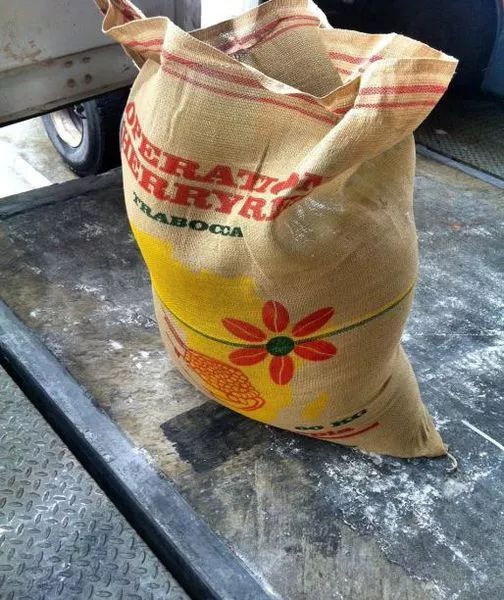
Specifically, Red Cherry plans to increase the purchase price of high-quality raw coffee beans to encourage coffee farmers to pay more attention to every process of picking and processing coffee beans. The coffee beans produced in this way are of better quality and taste, and can be better recognized in the end market, thus balancing the relatively high purchase price of coffee.
Trabocca produces the most accurate map of Ethiopia for coffee producing areas in Ethiopia.
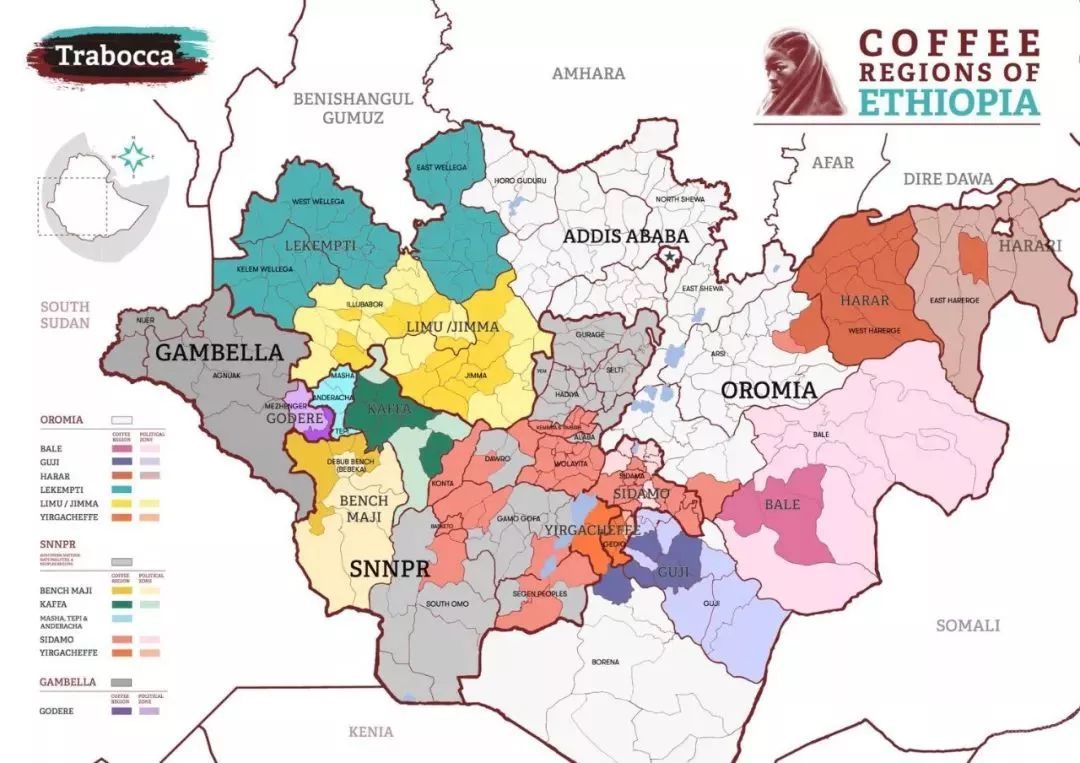
Photo Source: HKCG season Coffee
Nine boutique producing areas in Ethiopia
Yejia Xuefei (boutique producing area): 1800m-2000m above sea level | Pastoral coffee system |
Yega Xuefei is affiliated to the Sidamo producing area, which is separated separately because of its unique flavor. In addition to the small town of Yega Xuefei, it also includes three by-product areas around Wenago, Kochere, Gelena and Abaya. Therefore, Yirgacheffe A, Wenago A, Kochere An and Gelena/AbayaA will be more expensive than B of the same name in the new Yega Sheffield rating system. Yega Xuefei | five reasons to drink Yega Xuefei
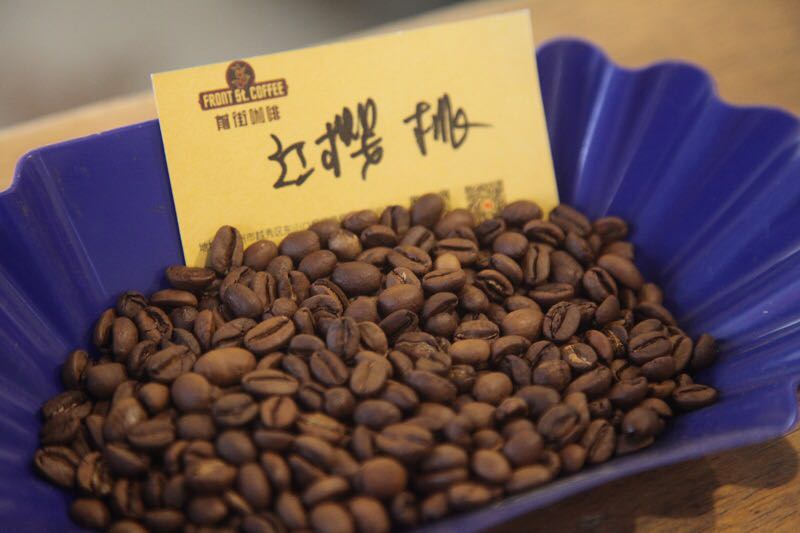
Sidamo (boutique producing area): 1400-2200m above sea level | Pastoral coffee system |
The flavor is similar to Yejiaxuefei, Sidamo, which is delicately washed or sunburned, has the same fragrance of flowers and oranges, and is worth as much as Yega Xuefei. The varieties in the two producing areas are similar, with medium-sized beans but also small seeds of dwarf plants, which farmers often sell separately. Common Kurmie, poor disease resistance; Wolisho; is tall and strong; Deiga, tree shape is medium, these three kinds are the main force of 90 + in boutique tanning series, 90 + candlestick is a good bean.

Liam (boutique producing area): 1200m to 2000m above sea level | Coffee system in pastoral, forest, semi-forest and planting fields |
The output is relatively small, and it is mainly exported to Europe and the United States, but it is not easy to buy in Taiwan, but it is very popular in Europe and the United States. there are three treatment methods: washing, tanning and semi-washing. Liam's body will be significantly less viscous, and the floral and citrus flavors will be inferior to those of Yegashifi and Sidamo, but with a hint of grass and black sugar, and bright acidity.

Hara (boutique producing area): 1500-2400 m above sea level | Pastoral coffee system |
Hara exclusive sun, is an ancient city in the east, but the city does not grow coffee, the so-called Hara coffee refers to the coffee produced by Haraji high and low in the Great Hara area. As the annual rainfall is only 1000 mm, all of them are treated in the sun. Hala caffeine is famous for its special aroma, which is typical of the early morning flavor in ancient times. she is tied with Yegashifi [double star].
If Hara's defective beans can be picked out, it is easy to drink berry aromas with slightly pleasant fermented aromas. However, due to various factors, the quality of Hara coffee is unstable in recent years, and the grading system is not true, so you must test or try it when you buy it.

Jinma (bulk commercial bean producing area): 1350-1850 m above sea level | Forest / semi-forest system |
Jinma is the capital of Kafa Forest or Kafa province. The English spelling is very messy. Most of the maps are jimma, but the coffee sacks are spelled into Djimmah. This is the largest coffee producing area in Ethiopia, accounting for 1 per cent of exports.
Kafa Forest is famous for its primitive wild varieties. Jinma is the distribution center of Kafa in this area. Farmers are used to picking and transporting the forest to Jinma, and then mixing hundreds of varieties together to sell as commercial beans, resulting in the aroma of many delicious varieties being masked.
Water washing boutique Jinma, although there is no Yega Xuefei orange fragrance and flower rhyme, the taste spectrum is also quite clean, similar to the Central American boutique. Commercial-grade boutique Jinma is very common in Taiwan, and luckily you can buy high-quality and inexpensive Jinma, which can drink the fragrance of lemon peel, which is not inferior to that of Sidamo. Overall, Jinma has a better flavor than Brazil's bulk commercial bean Santos, making it a good medium-to-low-priced formula bean.

Yilu Babo (bulk commercial bean producing area): altitude 1350-1850 | Forest / semi-forest coffee system |
This area is located in the west of Ethiopia, bordering Sudan, and is the most convenient producing area in the west. the complexity of coffee gene is only second to that of Kafa forest, beans are obviously larger than those of Yegashifi and Sidamo, low acidity, good viscosity and balanced flavor. Most of the coffee here is transported to Jinma to be mixed, rarely sold independently.
Jinbi, Liechuti (major commercial bean producing areas): 1500-1800 above sea level | Forest / semi-forest coffee system |
There are sun-washed and water-washed beans in this area, long-bodied beans similar to Hara, and a few boutique grades are quite popular in Europe and the United States. Most of the Hara, known as the poor, has a sour and fruity flavor due to Yilu Babo, with a bright flavor.
Tiebi, Bebeca (bulk commercial bean producing area): 500-1900m above sea level | Pastoral / forest / semi-forest coffee system |
The two producing areas are very close. Tiebi has an enterprise-managed coffee plantation in the north of Bebeca. In recent years, it has promoted the pastoral system and increased farmers' income, with an annual output of about 3000 tons. Both places have wild coffee, the yield is not high, the flavor is very different from Hara and Yega snow coffee, low acidity is the biggest feature, suitable for formula beans, sun and water washing.
Tana Lake (alternative production areas): 1840 meters above sea level | Forest system |
Monastery coffee, the annual output of the surrounding forest coffee is very small, less than 10 tons, in fact, can not be called the producing area, the lake area is full of Orthodox monasteries, churches, religious murals and myths, creating the most "divine" coffee in the world.
European monastic academics opened up a local coffee growing industry, which was later run by coffee communities or cooperatives in villages around the town. There are no special plantations here, and coffee trees are naturally scattered in the forest and countryside. During the harvest season, the Ethiopian Coffee Trading Company goes to town to buy coffee beans collected by farmers.

Important Notice :
前街咖啡 FrontStreet Coffee has moved to new addredd:
FrontStreet Coffee Address: 315,Donghua East Road,GuangZhou
Tel:020 38364473
- Prev
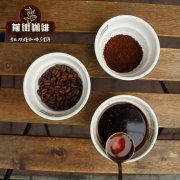
What are the flavor and taste characteristics of Venezuelan coffee beans? Does Venezuela produce more coffee?
Professional coffee knowledge exchange more coffee bean information please follow the coffee workshop (Wechat official account cafe_style) what are the flavor and taste characteristics of Venezuelan coffee beans? Does Venezuela produce more coffee? At the end of the 19th century, Venezuela began the coffee age, but with the imperialist countries in Africa and Asia, large-scale cultivation of cocoa and coffee beans, with inferior raw materials
- Next
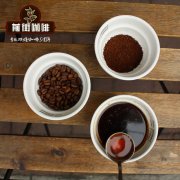
What chemical reaction changes will take place during the roasting process of coffee beans? What happened to the roasting of coffee beans
Professional coffee knowledge exchange more coffee bean information please follow the coffee workshop (Wechat official account cafe_style) coffee beans in the roasting process what chemical reactions will take place? What happened to the roasting of coffee beans? Sucrose: melting point 187.8 ℃-sugar? The conjugate = caramelization-water CO2 escapes to produce an explosive First Crack phenomenon. I measured the bean temperature 190 in the drum bean of the baking machine.
Related
- Detailed explanation of Jadeite planting Land in Panamanian Jadeite Manor introduction to the grading system of Jadeite competitive bidding, Red bid, Green bid and Rose Summer
- Story of Coffee planting in Brenka region of Costa Rica Stonehenge Manor anaerobic heavy honey treatment of flavor mouth
- What's on the barrel of Blue Mountain Coffee beans?
- Can American coffee also pull flowers? How to use hot American style to pull out a good-looking pattern?
- Can you make a cold extract with coffee beans? What is the right proportion for cold-extracted coffee formula?
- Indonesian PWN Gold Mandrine Coffee Origin Features Flavor How to Chong? Mandolin coffee is American.
- A brief introduction to the flavor characteristics of Brazilian yellow bourbon coffee beans
- What is the effect of different water quality on the flavor of cold-extracted coffee? What kind of water is best for brewing coffee?
- Why do you think of Rose Summer whenever you mention Panamanian coffee?
- Introduction to the characteristics of authentic blue mountain coffee bean producing areas? What is the CIB Coffee Authority in Jamaica?

